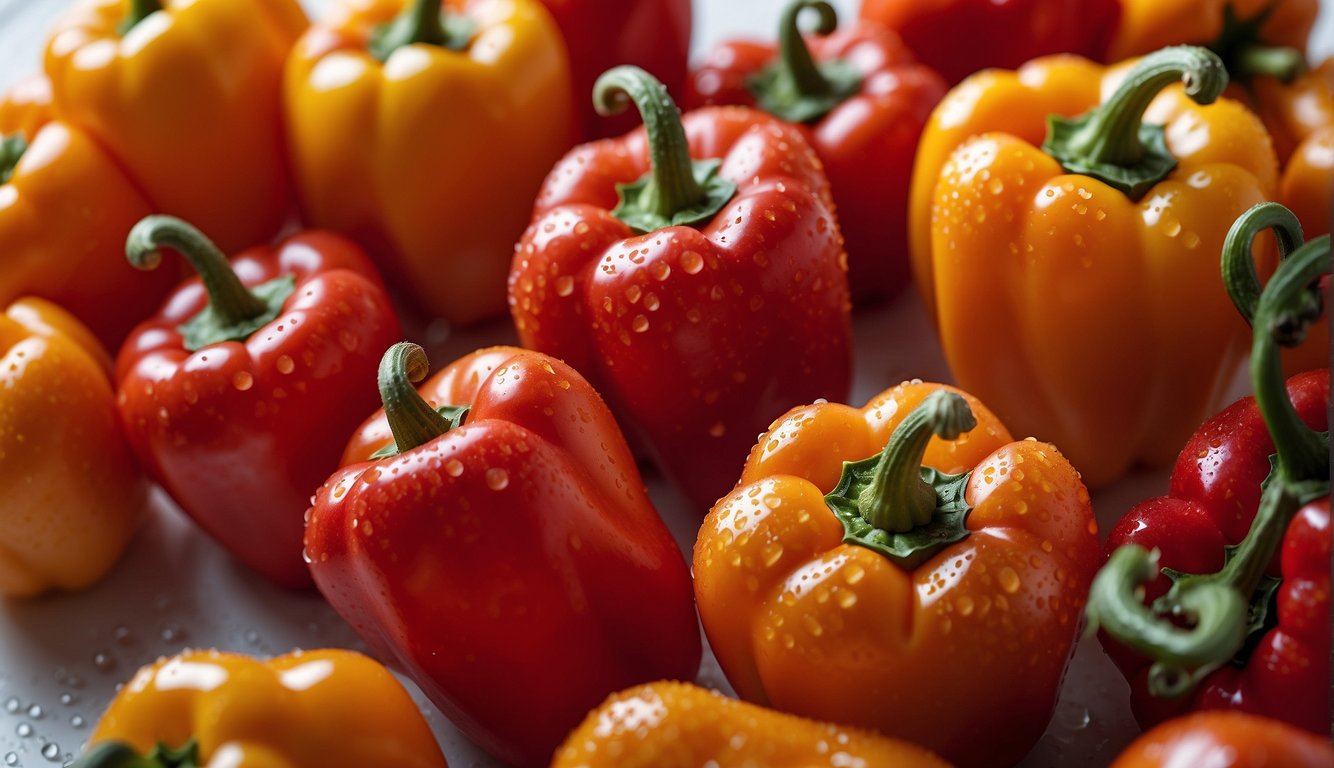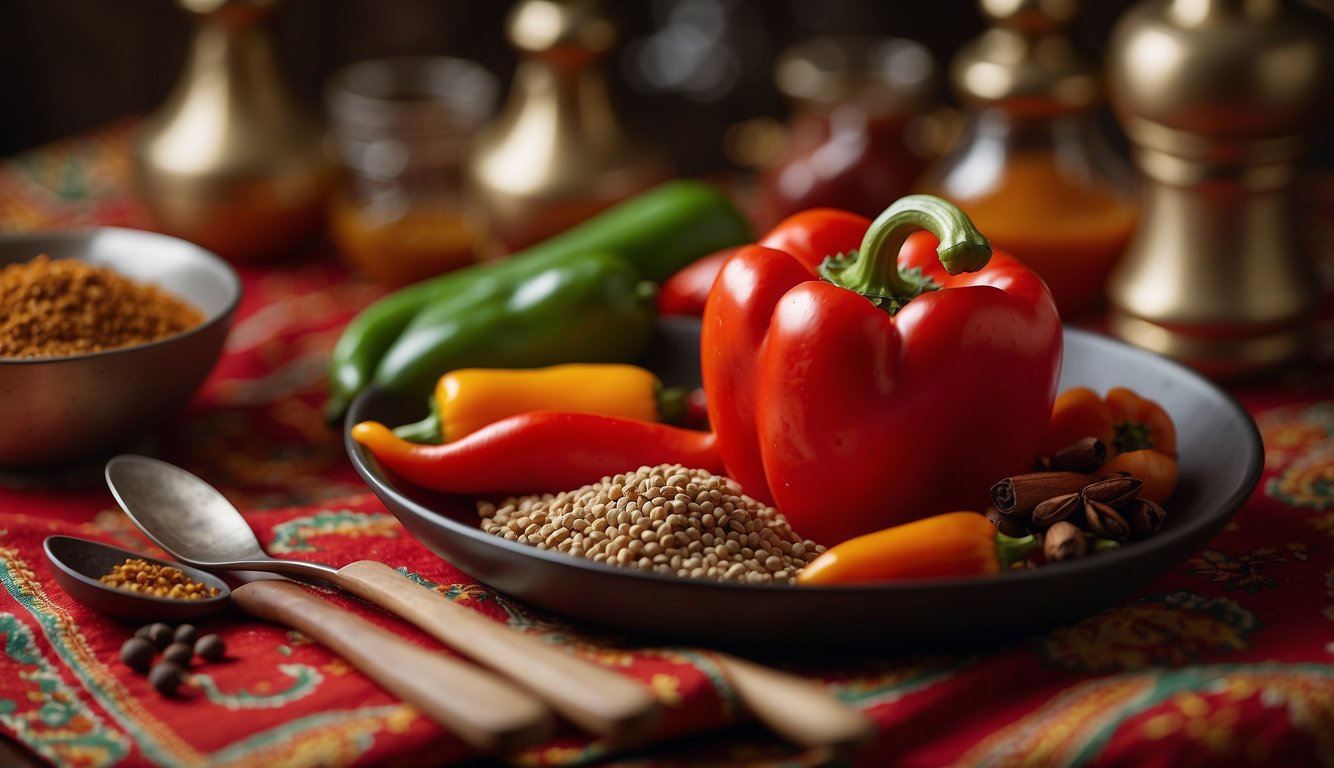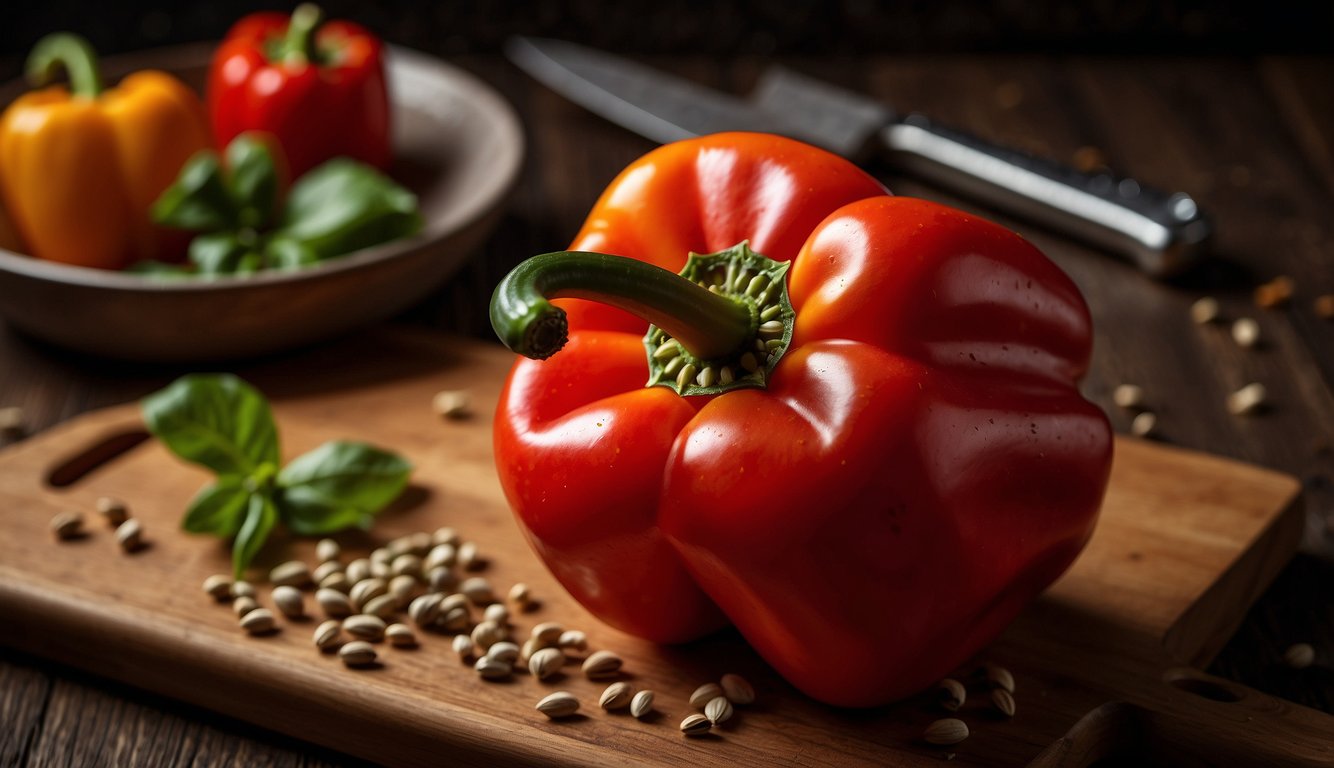Paul Johnston is the founder and master herbalist of The Herb Prof, with decades of clinical experience in naturopathic medicine, herbal remedies, detoxification and holistic wellness. After overcoming his own serious health challenges, he now dedicates himself to helping others reclaim their health naturally.
Red sweet pepper, commonly called bell pepper, is a widely enjoyed vegetable used in cuisines around the world. Although it is often harvested while still green, it ripens to a vibrant red, gaining both sweetness and added nutritional value. True to its name, the red sweet pepper is known for its bright color and naturally sweet flavor, making it a versatile ingredient in both savory and sweet dishes.
Red sweet pepper is a rich source of vitamins and minerals, including vitamins A, C, and K, folate, and potassium. It is also low in calories and high in fiber, making it a great addition to any diet. Additionally, it is a good source of antioxidants, which can help protect the body against damage from free radicals. Due to its sweet and mild flavor, it can be used in a variety of dishes, such as salads, stir-fries, soups, and stews.
Overall, red sweet pepper is a nutritious and delicious fruit that can add color and flavor to any dish. Whether you are looking to add more vegetables to your diet or simply want to experiment with new flavors, red sweet pepper is a great choice.
Historical Background
As a popular vegetable, the red sweet pepper has a rich history that spans several centuries. In this section, I will discuss the origins and domestication of the red sweet pepper and its global spread.
Origins and Domestication
The red sweet pepper is believed to have originated in South America, particularly in Mexico. According to archaeological evidence, the pepper has been cultivated in this region for over 7,500 years. The ancient Mesoamerican civilizations, such as the Maya and Aztecs, were known to have used pepper in their cuisine.
Over time, the pepper was domesticated and its cultivation spread throughout Central and South America. The domestication of the pepper allowed for the development of different varieties with unique characteristics, such as the red sweet pepper we know today.
Global Spread
The red sweet pepper was introduced to Europe by Christopher Columbus in the late 15th century. Initially, it was used as an ornamental plant, but it quickly gained popularity as a food item. The Europeans began cultivating the pepper and experimenting with different varieties, leading to the development of new strains.
In the 16th century, the pepper was introduced to the United States by Spanish and Portuguese explorers. The pepper was initially used in Hispanic cuisine, but it quickly became popular in other parts of the country.
Today, the red sweet pepper is widely cultivated and consumed around the world. It is a versatile vegetable that is used in a variety of dishes, from salads to stir-fries. Its popularity can be attributed to its sweet flavor, vibrant color, and nutritional value.
The red sweet pepper has a fascinating history that spans several centuries and continents. Its origins in South America and its global spread have contributed to its popularity as a beloved vegetable.
Botanical Classification

As a food enthusiast and a gardener, I always find it fascinating to learn about the botanical classification of the plants I grow in my garden. In this section, I will discuss the botanical classification of red sweet pepper, which is also known as red bell pepper.
Species and Varieties
Red sweet pepper belongs to the genus Capsicum, which is a part of the nightshade family Solanaceae. The Capsicum genus includes several species, including Capsicum annuum, Capsicum frutescens, Capsicum chinense, Capsicum baccatum, and Capsicum pubescens. Among these, Capsicum annuum is the most widely cultivated and consumed species.
There are several varieties of Capsicum annuum, including sweet peppers, chilli peppers, and paprika peppers. Sweet peppers, also known as bell peppers, are the most popular variety of Capsicum annuum. They are available in different colors, including red, green, yellow, orange, and purple, and have a sweet flavor. Green bell peppers are the unripe version of sweet peppers and have a slightly bitter taste.
Capsicum Annuum
Capsicum annuum is a species of chilli pepper that is native to South America and Central America. It is an annual plant that grows up to 3 feet tall and produces fruit that is used as a vegetable. The fruit of Capsicum annuum is a berry that can be eaten raw or cooked.
Capsicum annuum is a highly variable species, and many cultivars have been developed over the years. Some of the popular cultivars of Capsicum annuum include Anaheim, Jalapeno, Poblano, Serrano, and Thai chilli. Each cultivar has its unique flavor, heat level, and appearance.
Red sweet pepper belongs to the species Capsicum annuum, which is a part of the Capsicum genus. Capsicum annuum is a highly variable species that includes several cultivars, including sweet peppers and chilli peppers. Understanding the botanical classification of red sweet pepper can help you appreciate its unique flavor and nutritional value.
Health Benefits – Red Sweet Pepper
As a nutritionist, I always recommend including red-sweet peppers in your diet. They are packed with nutrients that can contribute to your overall health and well-being. In this section, I will discuss some of the health benefits of red-sweet peppers.
Dietary Advantages – Red Sweet Pepper
Red sweet peppers are low in calories and high in fiber, making them an excellent addition to a weight-loss diet. They are also an excellent source of vitamin C, which is essential for the growth and repair of tissues in your body. According to WebMD, red peppers are also a rich source of several vitamins, minerals, and antioxidant compounds that can help boost your immune system.
Antioxidant Properties
Red sweet peppers are known for their antioxidant properties, which can help protect your body from free radicals that can cause damage to your cells. According to the Cleveland Clinic, red bell peppers contain high levels of vitamin C and other plant compounds that can help prevent cancer and other chronic diseases.
In addition to vitamin C, red sweet peppers also contain other essential vitamins and minerals, including niacin, riboflavin, and potassium. They also contain capsaicin, which is known for its pain-relieving properties.
Overall, red sweet peppers are a delicious and nutritious addition to any diet. They are versatile and can be used in a variety of dishes, including salads, stir-fries, and sandwiches. So, next time you are at the grocery store, be sure to pick up some red sweet peppers and start reaping their health benefits.
Nutritional Profile
Red sweet peppers are not only delicious but also packed with essential nutrients that are vital for maintaining good health. Here is a breakdown of their nutritional profile.
Vitamins and Minerals
Red sweet peppers are an excellent source of vitamin C, providing about 190mg per 100g serving, which is more than double the daily recommended intake for adults. Vitamin C is an essential nutrient that plays a vital role in immune function, wound healing, and collagen synthesis.
They are also rich in potassium, which is essential for maintaining healthy blood pressure levels, nerve function, and muscle contraction. A 100g serving of red sweet pepper provides about 314.4mg of potassium.
Red sweet peppers are a good source of vitamin E, vitamin B6, and folate. Vitamin E is an antioxidant that helps protect cells from damage, while vitamin B6 and folate are essential for healthy brain function, red blood cell production, and DNA synthesis.
Dietary Fiber and Macronutrients
Red sweet peppers are low in calories, providing only about 31 calories per 100g serving. They are also low in protein, with only about 1.5g per serving.
However, they are an excellent source of dietary fiber, providing about 3.1g per serving. Fiber is essential for maintaining healthy digestion, regulating blood sugar levels, and reducing the risk of heart disease.
Red sweet peppers are also rich in vitamin A, particularly beta-carotene, which is essential for maintaining healthy vision, skin, and immune function. Additionally, they contain small amounts of minerals such as calcium, iron, magnesium and vitamin K.
Overall, red sweet peppers are a nutrient-dense food that can help boost your overall health and well-being.
Culinary Uses
Red sweet peppers are versatile ingredients that can be used in a variety of dishes. In this section, I will discuss some of the most popular culinary uses of red sweet peppers.
Cooking Techniques
When cooking with red sweet peppers, there are several techniques that you can use to bring out their flavor. One of the most popular techniques is roasting. Roasting red sweet peppers gives them a smoky flavor that is perfect for salads, soups, and sandwiches. To roast red sweet peppers, place them on a baking sheet and broil them until the skin is charred. Then, place them in a plastic bag and let them steam for a few minutes. Finally, remove the skin and seeds and slice the peppers into strips.
Another popular technique is stuffing. Stuffed peppers are a classic dish that can be made with a variety of fillings, including meat, rice, and cheese. To make stuffed peppers, cut off the top of the pepper and remove the seeds and membranes. Then, stuff the pepper with your desired filling and bake it in the oven until the pepper is tender.
Global Cuisine
Red sweet peppers are used in a variety of global cuisines. In Italian cuisine, they are often used as a topping for pizza and pasta dishes. In Mexican cuisine, they are used in fajitas and quesadillas. In Greek cuisine, they are used in salads and stuffed grape leaves. In Moroccan cuisine, they are used in tagines and couscous dishes.
Red sweet peppers are also a popular ingredient in many Middle Eastern and Mediterranean dishes. They can be used in dips, such as hummus and baba ghanoush, or salads, such as fattoush and tabbouleh. They can also be used as a snack, either raw or roasted, and are often served with dips or spreads.
Overall, red sweet peppers are a versatile ingredient that can be used in a variety of dishes. Whether you are making a salad, stuffing a pepper, or roasting them for a snack, red sweet peppers are sure to add flavor and nutrition to your meals.
Agricultural Practices – Red Sweet Pepper

As a red sweet pepper grower, I understand that proper agricultural practices are essential for a successful harvest. In this section, I will discuss the cultivation requirements, pest, and disease management practices that I use to ensure a healthy and productive crop.
Cultivation Requirements – Red Sweet Pepper
Growing peppers requires adequate sunlight, air circulation, and water. Therefore, I always plant my pepper plants in a location that receives at least 6 hours of sunlight daily. I also ensure that the soil is well-drained and rich in organic matter. To support the pepper plants, I use stakes or cages to prevent them from falling over.
Watering is crucial for pepper plants. I water my plants regularly, ensuring that the soil is moist but not waterlogged. Overwatering can lead to root rot, which can be detrimental to the health of the plant.
Fertilization is also necessary for the proper growth of pepper plants. I use organic fertilizers such as compost, manure, and bone meal to provide the necessary nutrients for my plants. Organic fertilizers are preferred as they are environmentally friendly and do not harm beneficial insects.
Pest and Disease Management
Pepper plants are susceptible to various pests and diseases, which can lead to a reduced yield. To manage pests, I use natural predators such as ladybugs and lacewings, which feed on aphids and other pests that attack pepper plants. I also use insecticidal soap and neem oil to control pests such as spider mites and whiteflies.
To prevent diseases, I ensure that my pepper plants are well-spaced to allow for adequate air circulation, which reduces the risk of fungal diseases. I also remove any infected leaves or plants promptly to prevent the spread of disease. Additionally, I rotate my crops to prevent the buildup of soil-borne diseases.
Proper agricultural practices are crucial for growing healthy and productive red sweet pepper plants. By following the cultivation requirements and pest and disease management practices discussed above, I have been able to grow a bountiful harvest of red sweet peppers.
Harvesting and Storage – Red Sweet Pepper
As a gardener, I always look forward to harvesting my sweet red peppers. Harvesting at the right time and storing them properly is crucial to ensure that they stay fresh and tasty for as long as possible.
Optimal Harvest Time – Red Sweet Pepper
The optimal time to harvest red sweet peppers is when they have fully ripened. These peppers are usually ready to be picked when they have turned a bright red color. Be sure to check the pepper’s size as well, as they should be around 3-4 inches in diameter.
It’s important to note that red bell peppers are not the same as green peppers. Green peppers are unripe and will not turn red if left on the plant. If you’re unsure about when to harvest your peppers, you can always refer to the seed packet or consult a gardening expert.
Preservation Methods
Once you’ve harvested your sweet red peppers, it’s important to store them properly to ensure that they stay fresh for as long as possible. Here are a few methods that I’ve found to be effective:
- Refrigeration: Sweet peppers can be stored in the refrigerator for up to two weeks. Place them in a plastic bag or container with a lid to keep them fresh.
- Freezing: If you have an abundance of peppers, consider freezing them for later use. Simply wash and slice the peppers, remove the seeds and membranes, and place them in a freezer bag. They can be stored in the freezer for up to 6 months.
- Drying: Drying peppers is another great way to preserve them. You can either air dry them by hanging them up in a dry, well-ventilated area or use a dehydrator. Once they’re fully dried, you can store them in an airtight container for up to a year.
Remember, the key to storing sweet red peppers is to keep them in a cool, dry place with good ventilation. Avoid storing them in direct sunlight or an area with high humidity. By following these tips, you can enjoy the delicious taste of sweet red peppers all year round.
Commercial Production – Red Sweet Pepper

As a farmer, I have found that sweet peppers, particularly red sweet peppers, are a profitable crop to grow. According to the USDA, bell peppers are one of the top 10 most commonly consumed vegetables in the United States. The demand for colored sweet peppers, including red, orange, yellow, and purple bell peppers, has increased in recent years due to their unique flavors and nutritional benefits.
Farming and Distribution – Red Sweet Pepper
Commercial production of sweet peppers requires proper planning and execution. The crop is typically grown in greenhouses or open fields. Greenhouse cultivation is preferred in regions where the temperature and humidity are not suitable for outdoor farming. Sweet peppers require a warm and humid environment with adequate sunlight, soil moisture, and nutrients. The crop can be grown from seeds or seedlings, depending on the farmer’s preference.
Once the sweet peppers are harvested, they are graded and sorted based on their size, color, and quality. The graded peppers are then packed and transported to the market. Sweet peppers are distributed through various channels, including supermarkets, grocery stores, and farmers’ markets. The distribution network is crucial in ensuring that the sweet peppers reach the consumers fresh and in good condition.
Market Varieties
Red sweet peppers are the most popular variety of sweet peppers in the market. They have a sweet and mild flavor and are commonly used in salads, stir-fries, and roasted dishes. Orange and yellow bell peppers are also popular among consumers due to their sweet taste and vibrant color. Purple bell peppers are less common but are gaining popularity due to their unique color and flavor.
As a farmer, it is essential to choose the right variety of sweet peppers to grow based on the market demand. The market demand for sweet peppers varies depending on the region and the season. It is crucial to conduct market research and stay updated on the latest market trends to make informed decisions.
Commercial production of red sweet peppers is a profitable venture for farmers. The crop requires proper planning and execution, and the distribution network is crucial in ensuring that the sweet peppers reach the consumers fresh and in good condition. It is essential to choose the right variety of sweet peppers to grow based on the market demand.
Cultural Significance – Red Sweet Pepper
Red sweet peppers have been a staple in many cultural dishes around the world. They have also been used for their symbolism and representation in various ceremonies and rituals.
Symbolism and Representation – Red Sweet Pepper
Red sweet peppers are often associated with love and passion due to their vibrant red color. In some cultures, they are even used as a symbol of fertility and abundance. For example, in Italy, red peppers are often given as a gift to newlyweds to represent a prosperous and fruitful marriage.
In addition to their symbolic meaning, red sweet peppers are also used in various religious and spiritual ceremonies. In Mexico and South America, chilli peppers are used as an offering to the gods during Day of the Dead celebrations. They are also used in healing rituals and to ward off evil spirits.
Cultural Dishes
Red sweet peppers are a popular ingredient in many cultural dishes around the world. In Europe, paprika is made from dried and ground red sweet peppers and is used as a seasoning in many dishes. Italian frying peppers are often used in Mediterranean cuisine, especially in dishes such as sausage and peppers. Cubanelle peppers are a staple in Latin American cuisine and are often used in dishes such as sofrito and picadillo.
Cherry peppers are also a popular ingredient in many dishes, especially in Asian cuisine. They are often pickled and used as a condiment or added to stir-fries for a spicy kick. Pimento peppers are a staple in Caribbean cuisine and are often used in jerk seasoning.
Overall, red sweet peppers have a rich cultural significance and are an important ingredient in many dishes around the world.
Red Sweet Pepper and Its Garden Friends

Let’s spice things up with the Red Sweet Pepper and its plant pals.
Firstly, we have basil. Basil and peppers are like two peas in a pod. Basil helps repel pests that love to snack on your peppers!
Next, let’s talk about spinach. Spinach is a great neighbor for peppers. It provides ground cover, keeping the soil cool and moist. Peppers love that!
Ever heard of marigolds? Plant them near your peppers. They deter nematodes and other pests. Plus, they add a pop of color to your garden!
And let’s not forget onions. Onions and peppers are a match made in garden heaven. Onions deter pests and can enhance the growth of your peppers.
Remember, folks, gardening is all about balance. So, let’s keep sowing, keep growing, and keep enjoying the fruits (and veggies) of our labor!
For more gardening tips and tricks, don’t forget to visit my homepage at theherbprof.com. Keep those green thumbs up!
References – Red Sweet Pepper
Little Herb Encyclopedia, by Jack Ritchason; N.D., Woodland Publishing Incorporated, 1995
The Ultimate Healing System, Course Manual, Copyright 1985, Don Lepore
Planetary Herbology, Michael Tierra, C.A., N.D., Lotus Press, 1988
Handbook of Medicinal Herbs, by James A. Duke, Pub. CRP Second Edition 2007
The Complete Medicinal Herbal, by Penelope Ody, Published by Dorling Kindersley
Check the Following Articles!
Unique Vegetables: Exploring Uncommon Varieties
Unusual Vegetables: A List of Unique & Flavorful Finds
Rare Vegetable List: 10 Unique & Nutritious Options to Try
Frequently Asked Questions – Red Sweet Pepper
How do you grow red sweet pepper plants from seeds?
Growing red sweet pepper plants from seeds is relatively easy. First, you need to choose a location that receives plenty of sunlight and has well-draining soil. Then, sow the seeds about 1/4 inch deep and cover them with soil. Keep the soil moist but not waterlogged, and the temperature between 70-80°F. Once the seedlings emerge, thin them out to one plant per pot or space them 18-24 inches apart in the garden. Water regularly and fertilize with a balanced fertilizer every two weeks. Harvest the peppers when they are fully ripe, red, and sweet.
What are some popular recipes that include red sweet peppers?
Red sweet peppers are versatile and can be used in many recipes. They are delicious roasted, grilled, sautéed, or raw in salads. Some popular recipes that include red sweet peppers are stuffed peppers, fajitas, stir-fries, kebabs, and pasta dishes. They can also be used to make dips, sauces, and spreads.
Can you list different types of sweet peppers?
There are many different types of sweet peppers, including bell peppers, banana peppers, pimento peppers, cherry peppers, and cubanelle peppers. Some other sweet pepper varieties include Marconi, Jimmy Nardello, and Gypsy.
What distinguishes sweet peppers from bell peppers?
Sweet peppers and bell peppers are the same thing. Bell peppers are a type of sweet pepper that has a blocky shape and thick flesh. They come in different colors, including green, red, yellow, and orange. Sweet peppers, on the other hand, can come in different shapes and sizes and are usually thinner than bell peppers.
What are the health benefits of consuming red sweet peppers?
Red sweet peppers are packed with vitamins and minerals, including vitamin C, vitamin A, potassium, and fiber. They also contain antioxidants that can help protect against cancer and heart disease. Eating red sweet peppers may also help improve digestion, boost immunity, and reduce inflammation.
What are the small, sweet varieties of red peppers called?
The small, sweet varieties of red peppers are called cherry peppers. They are usually about the size of a cherry and have a sweet, mild flavor. Cherry peppers are often used to make pickles or stuffed with cheese or meat.

